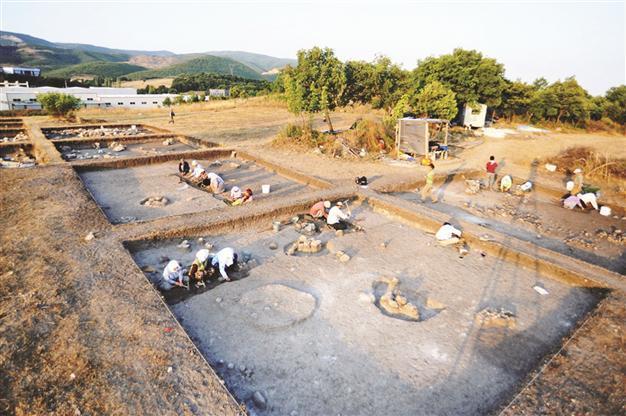Archaeopark of Bursa dates back 5,550 years
BURSA - Anatolia News Agency

The archaeological excavations at Bursa’s Akçalar reveals 8,500 years of history of the city. Turkey’s first archaeology park is under construction in the area. DHA photos
The excavation and archaeopark work on the South Marmara Archaeology Project at Bursa’s Aktopraklı tumulus was closed for the year.
Bursa Mayor Recep Altepe said the excavation had uncovered ruins from the Neolithic and Chalcolithic eras. “The work is still continuing, and we are doing our best to reveal the findings.” The new archaeopark project will introduce archaeology to society, Altepe said. “As a result of the excavation work, 70 years of the republican era, 600 years of the Ottoman era, the Seljuk era, the Roman and Bithynian eras, 3,000 years of walls have been restored in 10 years.”
Altepe said Bursa had a history dating back 3,500 years. The archaeological excavations at Akçalar revealed 8,500 years of history of the city, he added. “The academics have uncovered 200 to 300 years of history in this area. This will revive the archaeological site.”
Start of settled lifeIt is possible to learn about the lives of ancient agrarian societies, systems and houses. “We can learn how they lived and how they ate and much more,” he added.
“We will give the artifacts uncovered to the Culture, History and Archaeology Museum, which will be built very soon.” “We also want to build the first archaeopark in Bursa,” he added. Learning the history and culture of the region
Academic and excavation head Dr. Necmi Karul from the Prehistory Department of Istanbul University said, “The work started in 2004 and the ruins that have been unearthed will help people understand the culture and history of the region.”
Most of the artifacts are from the Neolithic era, Karul said. “The artifacts show that this settlement is from the start of settled life, replacing a nomadic one. With this, the rules of society began. These people are the ones who carried settled life to European continent.” Specialists have been working on the ancient sites of Miletepolis, Apollonia, Ryndacum and Lapadion in preparation for the opening of the archaeopark.
Archaeologists have also been focusing their efforts on examining the Aktopraklık Mound, which dates back to between 6500 and 5500 B.C., making it one of the oldest villages in northwestern Anatolia.
Scientists have extracted 15 structures so far and have created an exhibit out of four of them, according to Karul.
“Every year we make changes to our exhibits with the new data. In the following days, we are going to introduce the Chalcolithic era through new exhibits,” the professor said.
“Even archaeologists have a hard time making sense of the data, but we want to simplify the data to present it to the public. For example, many items are in pieces, but when the pieces are put together, they comprise the furnishings of a house,” Karul said.
“After a nine-year process, we have enough data to make an exhibit out of a village. We added a furnace and storage to the log cabins in the archaeopark,” he said.
The project is a joint project by Istanbul University and the Culture and Tourism Ministry.
